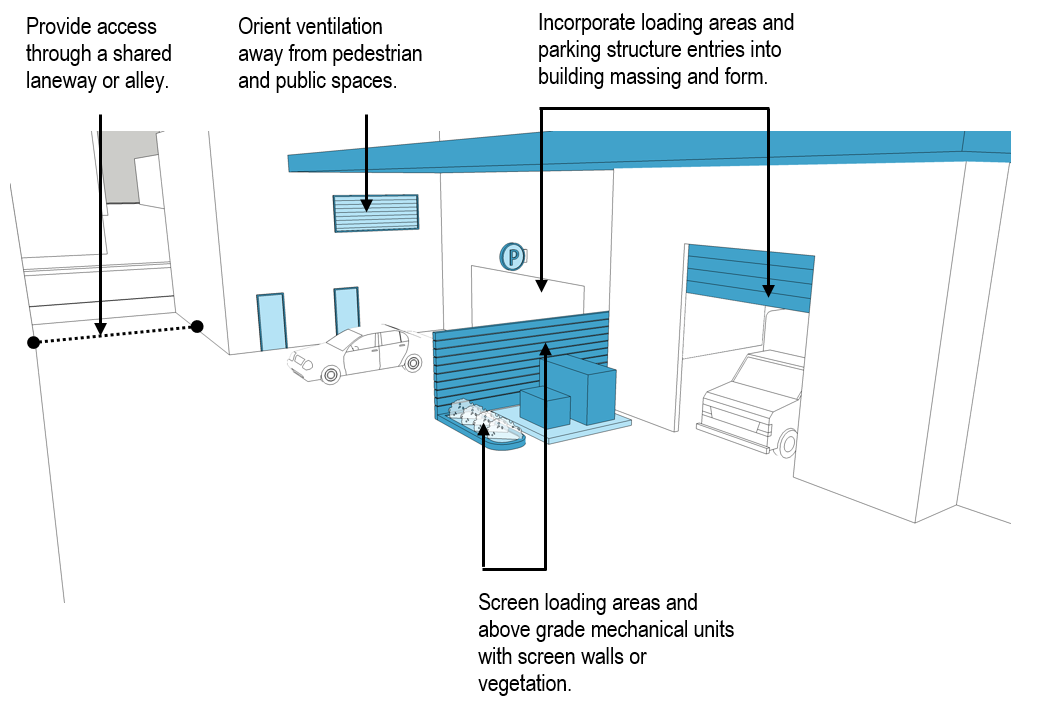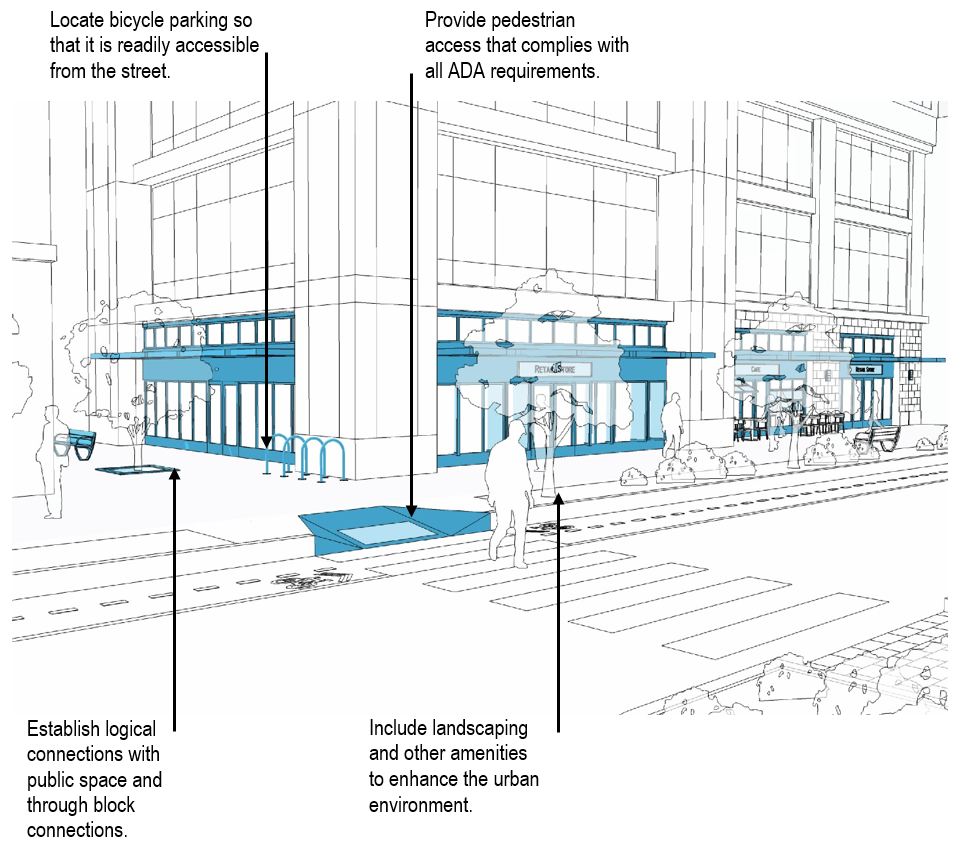20.25A.160 Site organization.
A. Introduction. Downtown Bellevue is unique in its 600-foot superblock configuration. These large blocks, which constitute the majority of the blocks in Downtown, create greater flexibility in site design. However, they also create a greater need to provide for street activation and coordinated internal circulation.
B. On-Site Circulation.
1. Intent. The vitality and livability of Downtown are dependent on a safe, walkable environment that prioritizes the pedestrian and reduces conflicts between pedestrians and other modes of transportation. The design should encourage the free flow of pedestrians, cyclists, and cars onto, off, and through the site. Walkability includes the creation of through-block pedestrian connections and other paths that offer attractive and convenient connections away from heavy arterial traffic. These connections also break down superblocks into a pedestrian-friendly grid.
2. Guidelines.
a. Site Circulation for Servicing and Parking.
i. Minimize conflicts between pedestrians, bicycles, and vehicles;
ii. Provide access to site servicing and parking at the rear of the building from a lane or shared driveway, if possible;
iii. Provide access to site servicing, such as loading, servicing, utilities, vehicle parking, either underground or within the building mass and away from the public realm and public view;
iv. Minimize the area of the site used for servicing through the use of shared infrastructure and shared driveways;
v. Provide service access through the use of through-lanes rather than vehicle turnarounds, if possible; and
vi. Locate above-ground mechanical and site servicing equipment away from the public sidewalk, through-block connections, and open spaces.
b. On-Site Passenger and Guest Loading Zones, Porte Cocheres, and Taxi Stands.
i. Plan for increased activity found in passenger and guest loading areas during site plan development. Loading functions shall take place on private property, except as provided below;
ii. Locate passenger and guest loading zones and taxi stands so that the public right-of-way will remain clear at all times;
iii. Locate passenger and guest loading zones and taxi stands to minimize conflicts with pedestrians and other modes of transportation. Limit the number and width of curb cuts and vehicular entries to promote street wall continuity and reduce conflicts with pedestrians, bicyclists, and other modes of transportation;
iv. Walkways should be placed to provide pedestrian access from the public sidewalk to the building entry without requiring pedestrians to walk in the driveway or come into conflict with vehicles;
v. Pull-through drives should have one lane that is one-way where they enter from and exit to the street;
vi. Long-term parking is not allowed in passenger and guest loading areas;
vii. If private bus activity is anticipated, provide an off-street passenger loading area for this size of a vehicle. Passenger loading functions may not take place in the public right-of-way; and
viii. Passenger loading functions for hotels, other than guest arrival and departure, may be allowed on streets with moderate intensity, such as a “C” Right-of-Way, via a curb setback loading area. Right-of-way classifications can be found in LUC 20.25A.170.B. Provided: the loading area must have a direct relationship to the building entry, and the required streetscape (curb, sidewalk, and planting strip) widths shall be maintained between the loading area and building entries, and the Director of Transportation has approved the configuration.

c. Pedestrian and Cycling Connections.
i. Include direct, logical, safe, and continuous routes for pedestrians and cyclists;
ii. Provide pedestrian access through the site that is available to all and consistent with the Americans with Disabilities Act;
iii. Include landscaping, pedestrian-scale lighting, and other amenities that enhance use of such connections during every season; and
iv. Locate bicycle parking so that it has direct and visible access to the public street, building entrances, transit, and other bicycle infrastructure.

C. Building Entrances.
1. Intent. Direct access from the public sidewalk to each building animates the street and encourages pedestrian activity to occur in the public realm rather than inside the building.
2. Guidelines. Ensure that the primary building entrances front onto major public streets, are well defined, clearly visible, and accessible from the adjacent public sidewalk.
D. Through-Block Pedestrian Connections.
1. Through-Block Pedestrian Connection Map.
Figure 20.25A.160.D.1.

2. Intent. A through-block pedestrian connection provides an opportunity for increased pedestrian movement through superblocks in Downtown and helps to reduce the scale of the superblocks.
3. Standards.
a. Location. Through-block pedestrian connections are required in each superblock as provided in the map above. A through-block pedestrian connection shall be outdoors, except where it can only be accommodated indoors. The Director may approve a location shift on a through-block pedestrian connection; provided, that it provides similar pedestrian access as would have been required in the map above.
b. Proportionate Share. If a new development is built adjacent to a required through-block pedestrian connection as provided in the map in subsection D.1 of this section, the applicant shall construct a proportionate share of the through-block pedestrian connection.
c. Hours. A through-block pedestrian connection shall be open to the public 24 hours a day. Provided, if the through-block pedestrian connection is within a building, its hours shall coincide with the hours during which the building is open to the public.
d. Legal Agreement. Owners of property that are required to provide a through-block connection as part of the Design Review process shall execute a legal agreement providing that such property is subject to a nonexclusive right of pedestrian use and access by the public during hours of operation.
e. Signage. Directional signage shall identify circulation routes for all users and state the hours that the space is accessible to the public. The signage shall be visible from all points of access. The Director shall require signage as provided in the City of Bellevue Transportation Department Design Manual. If the signage requirements are not feasible, the applicant may propose an alternative that is consistent with this section and achieves the design objectives for the building and the site.
4. Guidelines. A through-block pedestrian connection shall:
a. Form logical routes from its origin to its destination;
b. Offer diversity in terms of activities and pedestrian amenities;
c. Incorporate design elements of the adjacent right-of-way, such as paving, lighting, landscaping, and signage to identify the through-block pedestrian connection as a public space;
d. Accentuate and enhance access to the through-block pedestrian connection from the right-of-way by use of multiple points of entry that identify it as a public space;
e. Identify the connection as a public space through clear and visible signage;
f. Provide lighting that is pedestrian-scaled, compatible with the landscape design, and improves safety;
g. Provide high-quality design and durable materials;
h. Provide landscaping to define and animate the space wherever possible;
i. Incorporate trees and landscaping to provide enclosure and soften the experience of the built environment;
j. The use of artistic elements and water features is encouraged to provide moments of interest for the user;
k. Provide access that complies with the Americans with Disabilities Act. Additional access may be provided through the building, if necessary to meet this requirement;
l. Provide weather protection for pedestrians at key intersections, building entrances, or points of interest;
m. Be developed as a walkway or a combination walkway and vehicular lane. If the combination walkway and vehicular lane does not have a separate raised walkway, the walkway surface shall be paved with unit paver blocks or other unique paving surface to indicate that it is a pedestrian area;
n. Incorporate decorative lighting and seating areas; and
o. Be visible from surrounding spaces and uses. Provide windows, doorways, and other devices on the through-block connection to ensure that the connection is used, feels safe, and is not isolated from view.
E. Open Space.
1. Intent. Open space is an integral part of a livable urban environment because it provides people a place for recreation, gathering, and reflection in a built environment. A vibrant Downtown includes open spaces that encourage active and passive recreation, spontaneous and planned events, and the preservation of the natural environment.
2. Guidelines.
a. Site and building design should capitalize on significant elements of the natural environment, planned parks, outdoor plazas, and open space. Designs should incorporate open space amenities for residents, employees, and visitors. Depending on the location, this may be accomplished through integration of the natural environment with new development or providing a smooth transition between the natural and built environments;
b. Orient gathering places and walkways toward parks and open spaces. Provide clear and convenient public access to open space amenities;
c. Include elements that engage the natural environment where the sight, sound, and feel of nature can be directly experienced;
d. Locate buildings to take maximum advantage of adjacent open spaces;
e. Create attractive views and focal points;
f. Use publicly accessible open space to provide through-block pedestrian connections where possible;
g. Include features and programming opportunities to encourage year-round use;
h. Define and animate the edges of publicly accessible open space with well-proportioned building bases, permeable façades, and Active Uses at grade;
i. Provide access that complies with the Americans with Disabilities Act, additional access may be provided through the building if necessary to meet this requirement;
j. Provide weather protection for pedestrians at key intersections, building entrances, and points of interest;
k. Use artistic elements and water features where possible;
l. Use design elements, such as surface materials, furnishings, landscaping and pedestrian-scale lighting that are high quality, functional, and environmentally sustainable;
m. Maximize safety and comfort by including access to sunlight, clear views to and from adjacent streets and buildings, compliance with the Americans with Disabilities Act, and protection from wind and inclement weather;
n. Design for events where feasible by providing electrical hookups and areas for staging;
o. Open space design should not incorporate loading, refuse handling, parking, and other building and site service uses at the ground level façade, though such activities may be conducted in an open space when reasonable alternatives are not feasible. When the above-referenced activities must be incorporated into an Open Space Design, operational procedures shall require the above-referenced activities to occur after normal business hours; and
p. Employ decorative lighting.
Figure 20.25A.160.E.3.

(Ord. 6377, 10-16-17, § 2)